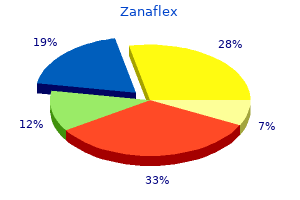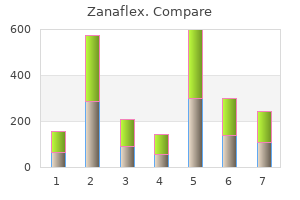





|
STUDENT DIGITAL NEWSLETTER ALAGAPPA INSTITUTIONS |

|
"Trusted zanaflex 4 mg, spasms hamstring".
G. Kan, M.S., Ph.D.
Medical Instructor, University of Mississippi School of Medicine
Thus spasms esophagus problems zanaflex 2 mg on line, the L1 spinal nerve lies below the Ll vertebra in the and the so 133 Histology Sources Summary 134 134 Nerve ingrowth 137 136 Ll-2 intervertebral foramen muscle relaxant jaw pain zanaflex 2mg on line, the L2 spinal nerve lies below the L2 vertebra muscle relaxant use in elderly order zanaflex 4 mg mastercard, on spasms down legs when upright buy 4mg zanaflex. Each is no longer than the width of the intervertebral foramen in which it Lies. The medial (or central) end of the spinal nerve may be difficult to define, for it depends on exactly where the dorsal and ventral roots of the nerve converge to form a single trunk. Sometimes, the spinal nerve may be very short, less than 1 mm, in which case the roots distribute their fibres directly to the ventral and dorsal rami without really forming a spinal nerve. The nerve roots are invested by pia mater and covered by arachnoid and dura as far as the spinal nerve. The dura of the dural sac is prolonged around the roots as their dural sleeve, which blends with the epineurium of the spinal nerve. The ventral root largely transmits motor fibres from the cord to the spinal nerve but may also transmit some sensory fibres. The ventral roots of the L1 and L2 spinal nerves additionally transmit preganglionic, sy mpathetic, efferent fibres. The spinal cord terminates in the vertebral canal opposite the level of the Ll-2 intervertebral disc, although it may end as high as T12-Ll or as low as L2-3. Within the dural sac, the lumbar nerve roots Tun freely, mixed with the sacral and coccygiaJ nerve roots to form the cauda equina, and each root is covered with its own sleeve of pia mater, which is continuous with the pia mater of the spinal cord. For the greater part of their course, the nerve fibres within each nerve root are gathered into a single trunk, but near the spinal cord they are separated into smaller bundles called rootlets, which eventually attach to the spinal cord. The size and number of rootlets for each nerve root are variable but in general they are 0. They do so by penetrating the dural sac in an inferolateral direction, taking with them an extension of dura mater and arachnoid mater referred to as the dural sleeve (see. This sleeve encloses the nerve roots as far as the intervertebral foramen and spinal nerve, where the dura mater merges with, or becomes, the epineurium of the spinal nerve (see. The pia mater of each of the nerve roots also extends as far as the spinal nerve, as does an extension of the subarachnoid space (see. Immediately proximal to its junction with the spinal nerve, the dorsal root forms an enlargement, the dorsal root ganglion, which contains the reB bodies of the sensory fibres in the dorsal root. The ganglion lies within the dural sleeve of the nerve roots and occupies the upper, medial part of the intervertebral foramen, but may lie further distally in the foramen if the spinal nerve is short. The angle at which each pair of nerve roots leaves the dural sac varies from above downwards. In general, the sleeves arise opposite the back of their respective vertebral Nerves of the lumbar spine 125 CuI edge 01 dural sac Cauda equina Dural sac sleeve Dural A B Figure 10. Thus, the L1 sleeve arises behind the L1 body, structures related to the nerve roots have already been described (see Ch. However, successively lower sleeves arise increasingly higher behind their vertebral bodies until the sleeve of the L5 nerve roots arises behind the 5), although the anatomy of the spinal blood vessels is described in detail in 11. Beyond the dural sac, individual pairs of roots are sheathed by pia, arachnoid and dura in the nerve root sleeves (Figs 10. The relevance of this relationship is that tumours or cysts of the dura or arachnoid can at times form space-occupying lesions that compress the roots. Some investigators, however, consider this to be a substantive structure which they call the epidural membrane. Ventrally, opposite the vertebral bodies, the membrane lines the back of the vertebral body and then passes medially deep to the posterior longitudinal ligament, where it attaches to the anterior surface of the deep portion of the ligament. The anterior relations of the dural sac, therefore, are the backs of the vertebral bodies and the intervertebral discs, and covering these As a whole, the dural sac rests on the floor of the structures is the posterior longitudinal ligament (see. Running across the floor of the vertebral and intervertebral foramina to demonstrate the relations of the lumbar nerve roots. The roots are enclosed in their dural sleeve, which is surrounded by epidural fat in the intervertebral foramina. Anteriorly, the roots are related to the intervertebral disc and posterior longitudinal ligament separated from them by the sinuvertebral nerves 5). This space, however, is quite narrow, for the dural sac is applied very closely to the osseoligamentous boundaries of the vertebral canal. Consequently, the membrane blends with the upper and lower borders of the anulus fibrosus but in a plane just anterior to that of the posterior longitudinal ligament. Opposite the intervertebral foramen, the membrane is drawn laterally to form a circumneural sheath around the dural sleeve of the nerve roots and spinal nerve.

However muscle relaxant easy on stomach purchase zanaflex 2mg otc, while the angle is the same spasms during mri zanaflex 4mg free shipping, the direction of this inclination alternates with each lamella muscle relaxant 2631 generic zanaflex 2 mg with mastercard. Anulus fibrosus the anulus fibrosus consists of collagen fibres arranged in a highly ordered pattern spasms cure order 4mg zanaflex with visa. These figures, however, constitute an average orientation of fibres in the mid- portion of any lamella. In any given quadrant of the anulus, some 40% of the lamellae are 10 and 20 incomplete, and in the posterolateral quadrant some lamellae (from the Latin lamella 50% are incomplete:1 An incomplete lamella is one that ceases to pass around the circumference of the disc. Around its terminal edge the lamellae superficial and deep to it either approximate or fuse. The lamellae are arranged in concentric rings which surround the nucleus pulposus (Figs 2. The lamellae are thicker towards the centre of the disc;4 they are thick in the anterior and lateral portions of the anulus but posteriorly they are finer and more tightly packed. Consequently the posterior portion of the anulus fibrosus is thinner than the rest of the anulus. S,6 Within each lamella, the collagen fibres lie parallel to one another, passing from the vertebra above to the 2. The two end plates of each disc, therefore, cover the nucleus pu)posus in its entirety, but peripherally they fail to cover the entire extent of the anulus fibrosus. Histologically, the endplate consists of both hyaline cartilage and fibrocartilage. Hyaline cartilage occurs towards the vertebral body and is most evident in neonatal and young discs (see eh. Fibrocartilage occurs towards the nucleus pulposus; in older discs the end plates are virtually entirely fibrocartilage (see Ch. The fibrocartilage is formed by the insertion into the endplate of collagen fibres of the anulus fibrosus. Where the endplate is deficient, over the ring apophysis, the collagen fibres of the most superficial lamellae of the anulus insert directly into the bone of the vertebral body (see. Because of the attachment of the anulus fibrosus to the vertebral endplates, the endplates arc strongly bound to the intervertebral disc. They are found in skin, bone, cartilage, tendon, heart valves, arterial walls, synovial fluid and the aqueous humour of the eye. Chemically, they are long chains of polysaccharides, each chain consisting of a repeated sequence of hvo molecules called the repeating unit. The collagen fibres of the inner two-thirds of the anulus fibrosus sweep around into the vertebral end plate, forming its fibrocartilaginous component the peripheral fibres of the anulus are anchored into the bone of t he ring apophysis. The molecule consists of a chain of sugar molecules, cach being a six-carbon ring (hexose). Every second sugar is a hexose-amine the chain is a repdition of identical pairs of hexose, hexose-amine units, called the repeating unit. Its core protein exhibits three coiled regions called globular domains (G1, G2 and G3) and two relatively straight regions called extended domains (El and E2l. Chondroitin sulphate binds to the terminal three-quarters or so of the E2 domain (Le. The N-terminal of the core protein bears the Gl domain, which is folded like an immunoglobulin; a similar structure is exhibited by the link protein. Proteoglycan aggregates are formed when several protein units arc linked to a chain of hyaluronic acid. Large proteoglycans thai aggregate with hyaluronic acid are characteristic of hyaline cartilage and they occur in immature intervertebral discs. PhysicochemicaUy, these molecules have attracting and retaining water property of (compare this with the water-absorbing properties of a ball of cotton wool). The volume enclosed by a proteoglycan molecule, and into which it can attract water, is known as its domain. The: core: protein exhibits three globular domains (G 1, G2 and G3J and two extended domains (Et and E2). The Gt domain is coiled like an immunoglobulin (lg), as is the link protein, and is the site of the aggrecan molecule that binds with hyaluronic add. The water binding capacity of any proteoglycan will therefore be largely dependent on the concentration of chondroitin sulphate within its structure.

Syndromes